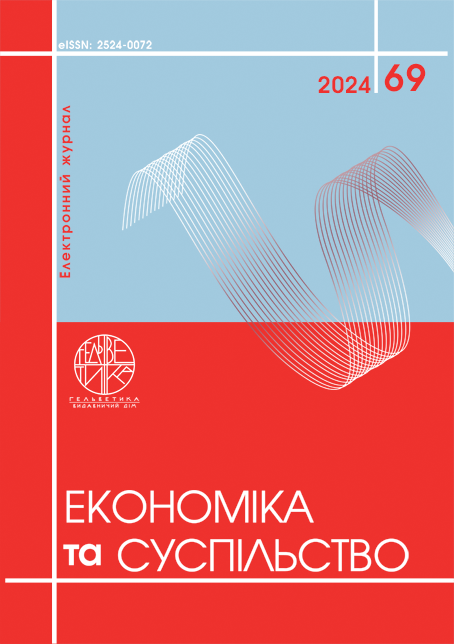METHODOLOGICAL APPROACHES TO ASSESSING THE EFFICIENCY OF ENTREPRENEURIAL ACTIVITY IN TERRITORIAL COMMUNITIES
Abstract
The article considers methodological approaches to assessing the effectiveness of entrepreneurial activity in territorial communities, which are becoming relevant in the context of decentralization. In this context, entrepreneurial activity becomes an important factor in the formation of local budgets, job creation, improving the quality of life of the population and ensuring social stability. The study indicates that traditional approaches to assessing entrepreneurial activity, based mainly on economic indicators, do not fully take into account the multidimensionality of this phenomenon. In particular, social, environmental and innovative aspects that are crucial for the development of communities are ignored. Therefore, there is a need to develop a comprehensive methodology that would take into account all key aspects of the impact of entrepreneurship on the community. A multifactorial approach to assessing the effectiveness of entrepreneurial activity is proposed, which is based on the integration of economic, social, environmental and innovative indicators. The economic component covers the level of investment activity, the number of enterprises created, the volume of tax revenues and the growth of community income. Social indicators reflect the creation of new jobs, the level of employment of the population, access to basic services and the quality of life of residents. The environmental component takes into account the impact of business activity on the environment, the use of renewable resources and the introduction of environmental technologies. The innovative component covers the level of business digitalization, the introduction of modern technologies into production processes and activity in supporting innovative initiatives. The methodology for assessing efficiency consists of four main stages. At the first stage, data is collected, which includes the analysis of statistical reports, sociological surveys, questionnaires of entrepreneurs and an assessment of the infrastructure and socio-demographic features of the community. The second stage involves the normalization of the collected data to ensure the possibility of comparison between communities that differ significantly in terms of development level and resource potential. At the third stage, multi-criteria analysis methods are used, such as the method of hierarchy analysis, matrix approach or integrated assessment. The final stage is the interpretation of the results and the development of recommendations for local authorities. The proposed methodology will provide local authorities with the opportunity to make informed decisions on supporting entrepreneurship, stimulating investment and developing infrastructure.
References
Білоцерківський, О.Б., Застьола, Є.О. Роль підприємництва в соціально-економічному розвитку ОТГ. Стратегічні пріоритети розвитку підприємництва, торгівлі та біржової діяльності: матеріали ІІ Міжнародної науково-практичної конференції. Запоріжжя, 2021 р. 389 с.
Шеленко, Д. ., Шпикуляк, О.Г., & Бойчук, А. В. (2024). Стратегічні пріоритети управління формуванням інвестиційного потенціалу розвитку територіальних громад на засадах активізації підприємництва. Економічний простір, (189), 85-90.
Ільченко, Т., & Застрожнікова, І. (2022). Роль аграрного підприємництва у розвитку територіальних громад. Економіка та суспільство, (37). URL : https://doi.org/10.32782/2524-0072/2022-37-21.
Рурак, І. (2023). Роль підприємництва в ефективному розвитку сільських територіальних громад. Організаційно-економічні та соціальні складові розвитку підприємництва: матеріали ІІ Всеукраїнської науково-практичної конференції. Львів: ЛНУП, 2023. 201с.
Матвієнко-Біляєва, Г.Л. (2018). Оцінка ефективності підприємницької діяльності. С. 327-330.
Линдюк А.О., Бурак А.І. Інтеграційні процеси малих підприємств у контексті раціонального поєднання виробничої та соціальної ефективності. Науковий вісник НУВМБТ імені С.З. Гжицького. 2012. Т.14. 4(54). С.310-316.
Bilotserkivskyi, O. B., Zastola, Ye. O. Rol pidpryiemnytstva v sotsialno-ekonomichnomu rozvytku OTH [The role of entrepreneurship in the socio-economic development of the UTC]. Stratehichni priorytety rozvytku pidpryiemnytstva, torhivli ta birzhovoi diialnosti: materialy II Mizhnarodnoi naukovo-praktychnoi konferentsii. Zaporizhzhia, 2021 r. 389 s. (in Ukrainian) 2. Shelenko, D. I., Shpykuliak, O. H., & Boichuk, A. V. (2024). Stratehichni priorytety upravlinnia formuvanniam investytsiinoho potentsialu rozvytku terytorialnykh hromad na zasadakh aktyvizatsii pidpryiemnytstva [Strategic priorities for managing the formation of investment potential for the development of territorial communities based on the activation of entrepreneurship]. Ekonomichnyi prostir – Economic space, (189), 85-90. (in Ukrainian)
Ilchenko, T., & Zastrozhnikova, I. (2022). Rol ahrarnoho pidpryiemnytstva u rozvytku terytorialnykh hromad [The role of agricultural entrepreneurship in the development of territorial communities]. Ekonomika ta suspilstvo – Economy and society, (37). Available at: https://doi.org/10.32782/2524-0072/2022-37-21. (in Ukrainian)
Rurak, I. (2023). Rol pidpryiemnytstva v efektyvnomu rozvytku silskykh terytorialnykh hromad [The role of entrepreneurship in the effective development of rural communities]. Orhanizatsiino-ekonomichni ta sotsialni skladovi rozvytku pidpryiemnytstva: materialy II Vseukrainskoi naukovo-praktychnoi konferentsii. Lviv: LNUP, 2023. 201s. (in Ukrainian)
Matviienko-Biliaieva, H. L. (2018). Otsinka efektyvnosti pidpryiemnytskoi diialnosti [Assessment of the effectiveness of entrepreneurial activity]. S. 327-330. (in Ukrainian)
Lyndiuk A.O., Burak A.I. (2012). Intehratsiini protsesy malykh pidpryiemstv u konteksti ratsionalnoho poiednannia vyrobnychoi ta sotsialnoi efektyvnosti [Integration processes of small enterprises in the context of a rational combination of production and social efficiency]. Naukovyi visnyk NUVMBT imeni S.Z. Hzhytskoho – Scientific Bulletin of the S.Z. Gzhytskyi National University of Medical Sciences and Technology. T.14. 4(54). S.310-316. (in Ukrainian)

This work is licensed under a Creative Commons Attribution 4.0 International License.


